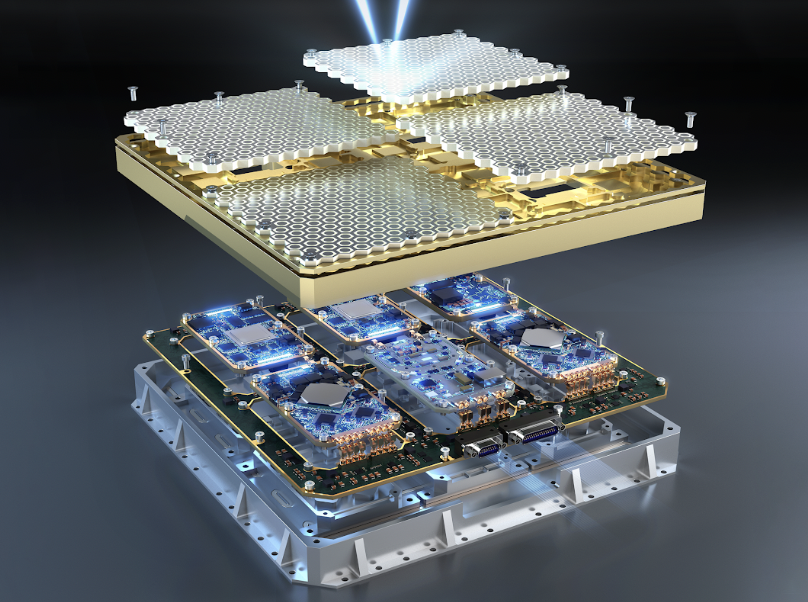Active phased arrays represent a transformative leap in radio frequency communication and will reshape how we connect and transmit data.
At its core, an active phased array antenna is a collection of individual antenna elements, each with its own amplifier and phase shifter. By altering the phase or timing and power level of each antenna element, the overall radio wave can be steered in desired directions without mechanically moving or rotating the antenna.
Phased arrays 101: Active phased arrays are low-profile antennas that focus RF energy into one or more digitally-steerable beams, meaning they can establish high data-rate links, reuse RF spectrum, and track users with no moving parts. The beams are controlled independently, which allows for the precise directing of focus, or ‘beamforming,’ much like a spotlight.
The take-over: While initially developed for military purposes, their advantages over traditional RF antennas have made them indispensable for space-based tech such as next-gen connected vehicles, in-flight connectivity, and satellite internet.
- SpaceX’s Starlink constellation, which now comprises ~50% of the satellites in LEO, is the most widespread use case, grabbing the attention of the Satcom industry. Starlink delivers high-speed internet to millions of users on Earth through its proprietary steerable phased array antennas.
- Nevertheless, Starlinks are limited by their reliance on Ku-band and are not available for other companies or satellite constellations.
Enter CesiumAstro
CesiumAstro is developing general-purpose phased array technology accessible to everyone across many frequencies, from L-Band to Ka-band and beyond, featuring a greater allocated spectrum for both defense and commercial applications.
Come one, come all: The company provides plug-and-play phased array communication payloads for a wide variety of customers and applications. Its modular systems are designed to be installed on various airborne and space platforms, including satellites, missiles, planes, and uncrewed aircraft.
“We can provide very sophisticated payloads using…LEGO-like building blocks that you can bolt together. And they are software-enabled, allowing on-orbit reconfiguration.” said CesiumAstro chief Shey Sabripour.
Why active phased arrays? The technology improves radio wave communications across nearly all operational considerations.
- No mechanical gimballing. Active phased arrays eliminate the need for satellite body pointing and pivoting. Fewer moving parts reduces the probability of failure.
- Optimized power usage. The antennas employ multiple strategies for power management, which is critical to maximizing performance on-orbit.
- Cost-effective. The tech is built via printed circuit boards, which can be mass-produced, driving down costs for businesses and end users.
- Adjust on orbit. Dynamic adjustment of performance allows operators to adapt services to meet changing mission objectives.
- Wide coverage. Active phased arrays can steer beam size, shape, and location as they move across the Earth’s surface, placing capacity where the users are located.
Use Cases
Communications: Active phased arrays bring significant agility to satellite communications. These systems can maintain efficient contact with ground stations, other satellites, and spacecraft moving at high velocities. The technology’s high throughput capabilities enable satellite operators to meet the growing global demand for fast space-based communications.
Earth observation: Phased array antennas eliminate the need for physically repositioning the satellite to downlink data and images. These antennas optimize power consumption by minimizing motion and enabling the satellite to focus on EO tasks.
Proximity operations: Performing on-orbit servicing and refueling tasks requires precise control of a spacecraft’s movement. Maintaining multiple concurrent movements, such as maneuvering a robotic arm while gimballing with a traditional antenna, is challenging.
- Phased arrays provide an effective solution to this issue. Electronically steered beams can facilitate continuous communication, eliminating the need for non-essential movement of the spacecraft.
In-flight connectivity: Multi-beam make-before-break phased arrays can be implemented on a wide range of passenger and uncrewed aircraft to provide high-performance connectivity.
- The low-profile and lightweight design of the phased array system has a lower impact on aircraft aerodynamics.
- It can be installed as a provider-agnostic system.
- Rapid handover through the constellation can eliminate Wi-Fi downtime.
Connected vehicles: Connectivity has become an essential feature in modern vehicles, with increasing importance placed on high-cost-of-failure autonomous driving capabilities. Active phased array technology can be vital in supporting firmware updates, safety features, data communications, and vehicle health monitoring.
Defense: The Pentagon is pursuing active phased array tech in its next-gen Proliferated Warfighter Space Architecture to improve its satellite, missile defense, and hypersonic detection assets. The benefits include maximizing capacity, improving spectrum utilization, optimizing coverage area, and extending mission life.
Space exploration: The near-real-time connectivity that active phased arrays provide can help enable human exploration by facilitating navigation and data downlinks for space vehicles such as rovers, landers, and space stations.
Rovers on the moon, for instance, need to communicate with satellites while driving. The ability to electronically point using active phased arrays is valuable, as it allows precise control over the direction and focus of signal transmission.
An IoT Future
As the world increasingly moves towards IoT connectivity, active phased array technology is poised to be a game-changer. IoT networks typically involve a multitude of connected devices, each transmitting and receiving data.
As global demand for data grows, so does the need for efficient, reliable, and high-capacity communication systems. By leveraging active phase array beamforming, high-speed data transmission, and versatile functionality, the technology is poised to power our data-hungry society and our emerging next-generation capabilities, including self-driving cars, 5G, 6G, and beyond.




